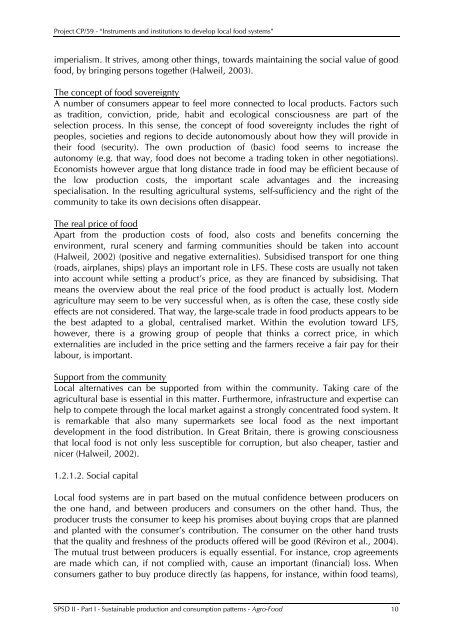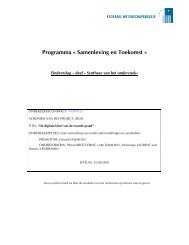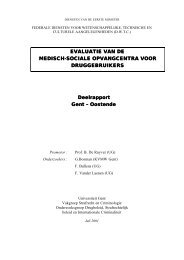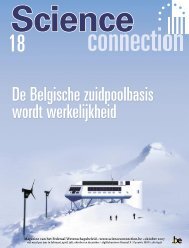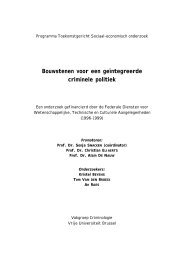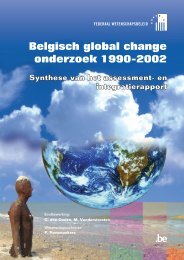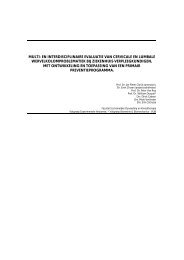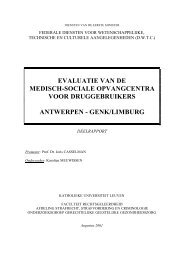chapter 3 inventory of local food systems
chapter 3 inventory of local food systems
chapter 3 inventory of local food systems
You also want an ePaper? Increase the reach of your titles
YUMPU automatically turns print PDFs into web optimized ePapers that Google loves.
Project CP/59 - “Instruments and institutions to develop <strong>local</strong> <strong>food</strong> <strong>systems</strong>”<br />
imperialism. It strives, among other things, towards maintaining the social value <strong>of</strong> good<br />
<strong>food</strong>, by bringing persons together (Halweil, 2003).<br />
The concept <strong>of</strong> <strong>food</strong> sovereignty<br />
A number <strong>of</strong> consumers appear to feel more connected to <strong>local</strong> products. Factors such<br />
as tradition, conviction, pride, habit and ecological consciousness are part <strong>of</strong> the<br />
selection process. In this sense, the concept <strong>of</strong> <strong>food</strong> sovereignty includes the right <strong>of</strong><br />
peoples, societies and regions to decide autonomously about how they will provide in<br />
their <strong>food</strong> (security). The own production <strong>of</strong> (basic) <strong>food</strong> seems to increase the<br />
autonomy (e.g. that way, <strong>food</strong> does not become a trading token in other negotiations).<br />
Economists however argue that long distance trade in <strong>food</strong> may be efficient because <strong>of</strong><br />
the low production costs, the important scale advantages and the increasing<br />
specialisation. In the resulting agricultural <strong>systems</strong>, self-sufficiency and the right <strong>of</strong> the<br />
community to take its own decisions <strong>of</strong>ten disappear.<br />
The real price <strong>of</strong> <strong>food</strong><br />
Apart from the production costs <strong>of</strong> <strong>food</strong>, also costs and benefits concerning the<br />
environment, rural scenery and farming communities should be taken into account<br />
(Halweil, 2002) (positive and negative externalities). Subsidised transport for one thing<br />
(roads, airplanes, ships) plays an important role in LFS. These costs are usually not taken<br />
into account while setting a product’s price, as they are financed by subsidising. That<br />
means the overview about the real price <strong>of</strong> the <strong>food</strong> product is actually lost. Modern<br />
agriculture may seem to be very successful when, as is <strong>of</strong>ten the case, these costly side<br />
effects are not considered. That way, the large-scale trade in <strong>food</strong> products appears to be<br />
the best adapted to a global, centralised market. Within the evolution toward LFS,<br />
however, there is a growing group <strong>of</strong> people that thinks a correct price, in which<br />
externalities are included in the price setting and the farmers receive a fair pay for their<br />
labour, is important.<br />
Support from the community<br />
Local alternatives can be supported from within the community. Taking care <strong>of</strong> the<br />
agricultural base is essential in this matter. Furthermore, infrastructure and expertise can<br />
help to compete through the <strong>local</strong> market against a strongly concentrated <strong>food</strong> system. It<br />
is remarkable that also many supermarkets see <strong>local</strong> <strong>food</strong> as the next important<br />
development in the <strong>food</strong> distribution. In Great Britain, there is growing consciousness<br />
that <strong>local</strong> <strong>food</strong> is not only less susceptible for corruption, but also cheaper, tastier and<br />
nicer (Halweil, 2002).<br />
1.2.1.2. Social capital<br />
Local <strong>food</strong> <strong>systems</strong> are in part based on the mutual confidence between producers on<br />
the one hand, and between producers and consumers on the other hand. Thus, the<br />
producer trusts the consumer to keep his promises about buying crops that are planned<br />
and planted with the consumer’s contribution. The consumer on the other hand trusts<br />
that the quality and freshness <strong>of</strong> the products <strong>of</strong>fered will be good (Réviron et al., 2004).<br />
The mutual trust between producers is equally essential. For instance, crop agreements<br />
are made which can, if not complied with, cause an important (financial) loss. When<br />
consumers gather to buy produce directly (as happens, for instance, within <strong>food</strong> teams),<br />
SPSD II - Part I - Sustainable production and consumption patterns - Agro-Food 10


